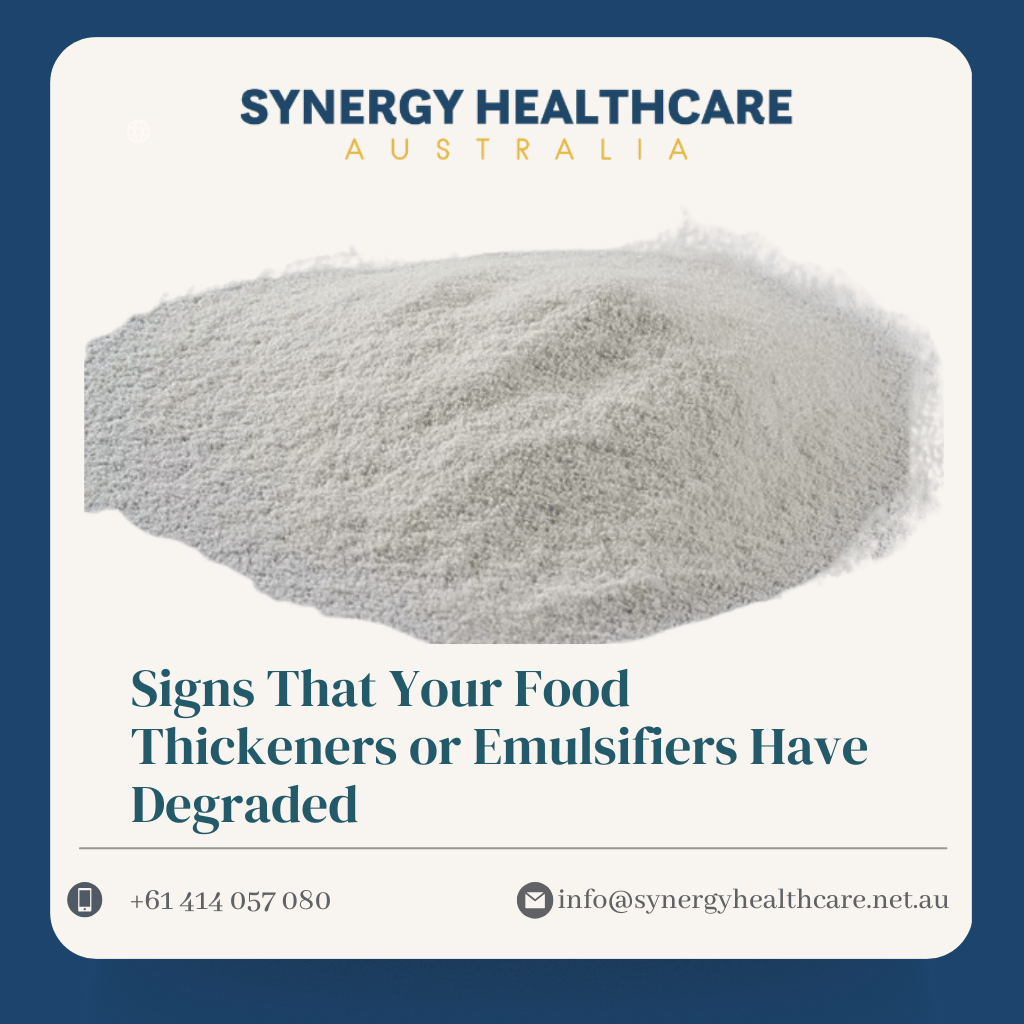Ever opened a pack of xanthan gum and found it clumpy or smelly? Or maybe your go-to emulsifier suddenly stopped working in your sauce recipe? If you’re working with food additives—especially in Australia’s hot and humid climate—you need to know when your ingredients have passed their prime.
At Synergy Healthcare, we’ve been helping manufacturers and commercial kitchens across Australia maintain food quality by supplying high-grade, FSANZ-compliant emulsifiers and thickeners. And trust us—using degraded additives can cause texture issues, food separation, or even product recalls.
Let’s explore the tell-tale signs that your food thickeners or emulsifiers might be compromised, and what you can do to prevent it.
Understanding Food Thickeners and Emulsifiers
Before we get into the signs, let’s quickly break down what these ingredients do:
- Food thickeners (like guar gum, xanthan gum, and carrageenan) enhance the viscosity and texture of food without altering the flavour.
- Emulsifiers (like lecithin and mono- and diglycerides) help blend ingredients like oil and water, preventing separation in dressings, sauces, and more.
Both are essential in Australia’s booming processed food, bakery, dairy, and plant-based product sectors.
Why Food Additives Degrade Over Time
Degradation doesn’t just happen because of age—it’s often due to how the product was stored or handled.
- Moisture exposure: Causes clumping, spoilage, or microbial growth.
- High temperatures: Break down the chemical structure.
- Poor sealing: Leads to oxidation or contamination.
- Time: Even unopened products have a shelf life—typically 6–12 months.
📊 Did you know? According to industry data, improper storage accounts for over 30% of food additive waste in commercial kitchens across Australia.
Physical Signs Your Thickeners or Emulsifiers Have Gone Bad
1. Clumping or Hardening
If your powder-based thickener isn’t free-flowing anymore, it may have absorbed moisture. Gums like guar and xanthan are especially sensitive to humidity.
🟡 Tip: If it feels like gravel instead of a soft powder, it’s time to bin it.
2. Discolouration
Lecithin should be golden to light brown. If it turns dark, or your powders show spots or yellowing, the product has likely oxidised or gone mouldy.
3. Unusual Odour
Emulsifiers like soy lecithin have a mild, nutty scent. If yours smells sour, musty, or rancid, it’s probably spoiled.
4. Inconsistent Texture When Mixed
If your thickener used to blend smoothly but now causes lumps, stringiness, or separation, its structure may have degraded.
Functional Signs of Degradation in Finished Products
1. Separation in Emulsified Products
You’ll notice it in mayonnaise, sauces, or salad dressings that separate shortly after mixing. It means your emulsifier isn’t doing its job anymore.
2. Loss of Thickness or Gel Stability
Your once-thick custard or soup now turns runny? The thickener’s binding ability has likely weakened.
3. Unusual Taste
While most thickeners and emulsifiers are neutral in flavour, degraded ones can cause a bitter, sour, or metallic taste in the final product.
4. Faster Spoilage
Additives often help stabilise products. If your final food spoils quicker than usual—even when stored properly—it could be due to degraded additives.
How to Check the Quality of Food Additives Before Use
✅ Always do the following before using a new or previously opened pack:
- Check the best-before date
- Do a visual and smell check
- Run a small test batch in water or your base recipe
- Review the supplier’s certificate of analysis (COA)
At Synergy Healthcare, all our food thickeners and emulsifiers come with technical specs and shelf-life guidelines to make your job easier.
Best Storage Practices to Extend Shelf Life
Here’s how to protect your ingredients from Aussie heat and humidity:
- Store in cool, dry places (ideally below 25°C)
- Use airtight containers after opening
- Avoid frequent opening and closing of bulk packs
- Label the opening date and use FIFO (First In, First Out) method
🏷️ Storage Tip: For powdered thickeners, use moisture-absorbing sachets if storing long-term.
When to Replace Food Additives Immediately
Replace your thickener or emulsifier immediately if:
- The packaging is damaged or improperly sealed
- You see any mould, pests, or odd colours
- The powder has turned rock solid
- It’s been more than 12 months since opening, even if it looks okay
Importance of Sourcing from Trusted Suppliers
Not all products in the market are created equal. Poor-quality additives can:
- Degrade faster
- Perform inconsistently
- Lead to compliance issues with FSANZ
As one of the trusted food emulsifier suppliers in Australia, Synergy Healthcare ensures that you get top-quality, food-grade ingredients with full traceability and support.
Conclusion
So, if you’ve been wondering whether your food thickeners or emulsifiers are still good to use—trust your eyes, nose, and product results. Ingredient degradation doesn’t just affect the quality of your food—it can also affect customer satisfaction, shelf life, and compliance.
At Synergy Healthcare, we help you stay ahead by supplying reliable, high-quality food additives that are FSANZ-compliant, well-documented, and properly stored from production to delivery.
✅ FAQs – Signs That Your Food Thickeners or Emulsifiers Have Degraded
Q1. How long do food emulsifiers and thickeners last?
Typically 6 to 12 months, depending on storage conditions and packaging. Always check expiry and do a quick inspection before use.
Q2. Can I still use food additives past their best-before date?
It’s not recommended. The function and safety can’t be guaranteed. If the product looks or smells off—discard it.
Q3. What happens if I use degraded thickeners in my food?
You may experience texture issues, product separation, off taste, or even faster spoilage.
Q4. What’s the best way to store food thickeners in a commercial kitchen?
Keep them in airtight containers, away from light, heat, and moisture. Use moisture absorbers if needed.
Q5. Where can I buy reliable emulsifiers in Australia?
From trusted food emulsifier suppliers like Synergy Healthcare, who provide FSANZ-compliant, quality-tested ingredients.


